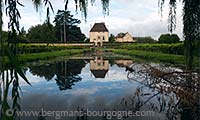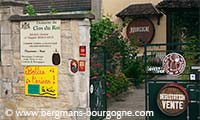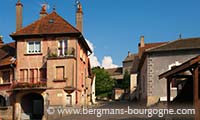
here was a time when the Joigny vineyards covered hundreds of hectares. At the time of the French revolution 540 hectares were under vines. Before that, in the 11th century, as much as 800 hectares had been under vines. Then, towards the end of the 19th century, things began to change. For centuries the producers around Auxerre and Chablis had been providing the Paris market with wine, easily transported on the Yonne and the Seine into the French capital. The arrival of the railway brought stiff competition from the wine producers in the south of France. In combination with the phylloxera crisis, followed by two world wars, not much was left of the Auxerrois vignoble in the end.
 In the 1940's, during World War II, only a few hectares remained in Joigny. In 1970 the surface area was down to one hectare and a half. Many vineyards were abandoned, even up on the south facing slope above the town, the Côte Saint Jacques, considered to produce the best wines in Joigny, much was left en friche. At the bottom of the slope the town was slowly moving in. Houses were built in the vineyards and that would probably have continued if not the local authorities had changed the town planning scheme. From then on the Côte Saint Jacques could only be used for growing vines.
In the 1940's, during World War II, only a few hectares remained in Joigny. In 1970 the surface area was down to one hectare and a half. Many vineyards were abandoned, even up on the south facing slope above the town, the Côte Saint Jacques, considered to produce the best wines in Joigny, much was left en friche. At the bottom of the slope the town was slowly moving in. Houses were built in the vineyards and that would probably have continued if not the local authorities had changed the town planning scheme. From then on the Côte Saint Jacques could only be used for growing vines.
The 1970's was the turning point for the Joigny vignoble. Slowly the area under vines began to grow. In 1973 Jacques Vignot of Domaine Vignot in Paroy-sur-Tholon set about having the Joigny vineyards recognised by the INAO (Institut National des Appellations d'Origine). Two years later, in 1975, the regional appellation Bourgogne Côte Saint Jacques was created, covering only the vineyards above Joigny. The vineyards outside the Côte Saint Jacques were included in the Bourgogne appellation.
The Bourgogne Côte Saint Jacques covers all three colours – red, white and rosé. In this case the rosé is special. From 1936 to 1973 it was labelled as Vin gris de Joigny Côte-Saint-Jacques, a wine halfway between orange and pink in colour and not made from pinot noir grapes.
 In the past the vin gris from Joigny was made from a blend of four different grape varieties – epicier (sauvignon), plant du roi (malbec), verot (tressot) and pinot gris. Today most producers, like Domaine Christophe Lepage and Domaine Alain Vignot, make their vin gris from 100 per cent pinot gris. Michel Lorain at Domaine du Clos Saint Jacques is the exception. In 1995 he planted one hectare with the four varieties in order to try recreate the vin gris of the old days.
In the past the vin gris from Joigny was made from a blend of four different grape varieties – epicier (sauvignon), plant du roi (malbec), verot (tressot) and pinot gris. Today most producers, like Domaine Christophe Lepage and Domaine Alain Vignot, make their vin gris from 100 per cent pinot gris. Michel Lorain at Domaine du Clos Saint Jacques is the exception. In 1995 he planted one hectare with the four varieties in order to try recreate the vin gris of the old days.
Michel Lorain is perhaps best known for his Michelin-starred restaurant in Joigny, the Côte Saint Jacques. He received his first star in 1971, the second in 1976 an the third in 1986. His son, Jean-Michel Lorain, joined him in 1983. In 2001 Jean-Michel took on the sole responsibility for the restaurant.
Today there are 55 hectares of vines in Joigny. If you include the neighbouring villages Champvallon and Volgré it is a total of 70 hectares. The Côte Saint Jacques accounts for 12,36 hectares – 11,94 for the reds and rosés, 0,42 hectare for the whites. The soil is flinty clay on Turonian limestone. At the top of the hill is a forest, the forêt d'Othe, protecting the vines from the north wind. With the Yonne below the slope the vines are protected from the frost in the spring.
© 2015 Ola Bergman













